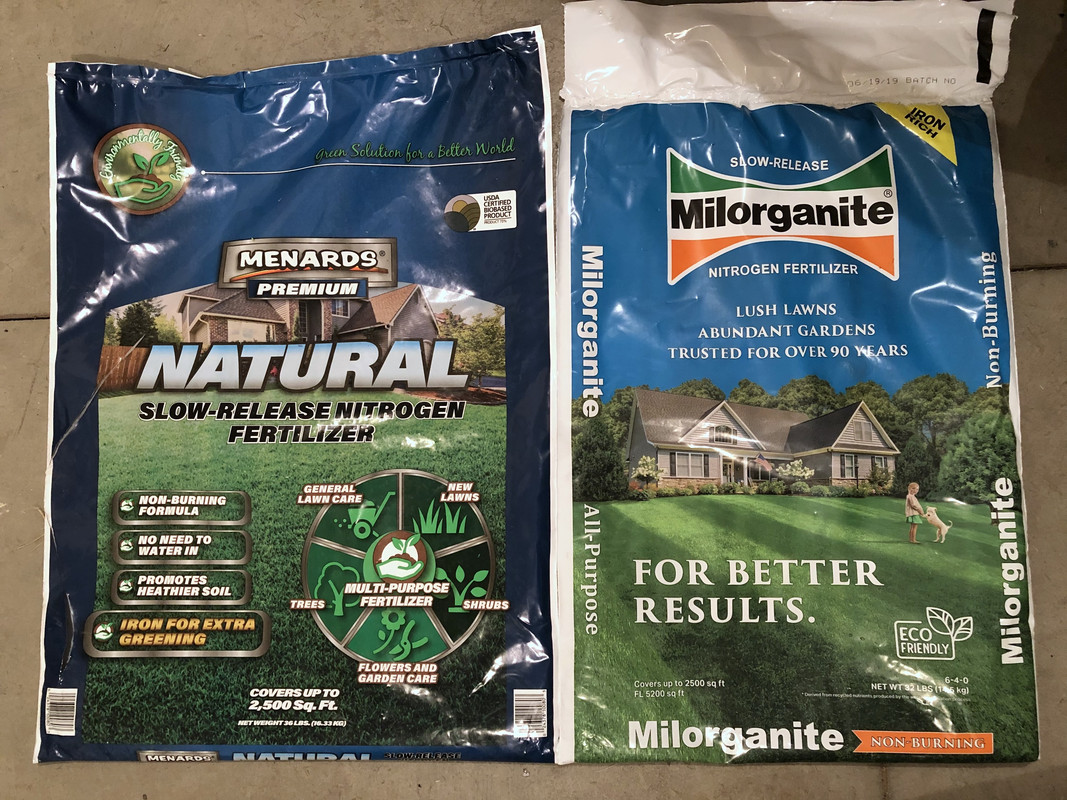If you haven't seen it yet, Menards has a new Milorganite substitute. They recently changed the bag to a blue design (it was a tan bag before). I believe the analysis is the same as the old version. It is made by EC Grow, which is the company that makes all of Menards fertilizers. No idea what the source of the biosolids is, but the company is based in Eau Claire, WI. Here is a picture of the labels side-by-side:


The label is also available on Menards website as a PDF if you can't see clearly enough.
Menards Natural 4-3-0
Milorganite 6-4-0
Interestingly, the spreader settings are virtually the same even though you have to apply 12.5% more mass of the Menards product (more on this later).
Otherwise looking at the numbers, obviously Milo is the more concentrated product, and when used as directed will give you more N, P, and Fe. The Menards fertilizer will give you more calcium. The other big difference is the ratio of water insoluble to soluble nitrogen. In the Menards product the ratio is much higher, which could mean the nitrogen is released more slowly than Milo.
I applied both products the same day, and these were my impressions. Smell was roughly similar between the two products. Milorganite is a fine, gray, granular solid, and spreads very quickly and evenly. The product seemed extremely homogenous. In contrast, the Menards product had much larger granules, which were on par with most traditional granular fertilizers, as was spreading performance (average). The product was also gray, but had some noticeable black and white granules mixed in (very low percentage). Not completely sure, but it's possible they added some urea and iron to the biosolids to meet their analysis specifications. Larger particles flow through the spreader holes more slowly, so it is perplexing why the spreader settings for the Menards product aren't higher. On my particular spreader, I apply Milo at about a 7, and I did the Menards product wide open (10) to compensate for the larger particles and slower flow rate. With the larger setting, I was roughly able to meet my area target. I will post an update if I notice a difference in response to the fertilizers in the coming weeks.
Milorganite does seem to be the better product, but the best value depends on the price difference where you live. Being close to the source, Milo is only $1/bag more expensive than the Menards fertilizer, and therefore Milo is the better buy for me. If your Milo is really expensive, then the Menards might be the better value. And finally, if you are experiencing a Milo shortage, but can get the Menards Natural, I would buy it because it's better than going home empty handed.


The label is also available on Menards website as a PDF if you can't see clearly enough.
Menards Natural 4-3-0
36 lb. bag, covers 2500 ft2[/sup]
0.58 lbs N/1000 ft[sup]2[/sup]
Nitrogen..........3.5%/0.5% water insoluble/soluble (7:1 ratio)
Calcium..........3.4%
Sulfur..........1.0%
Iron.........1.5%
Milorganite 6-4-0
32 lb. bag, covers 2500 ft[sup]2[/sup]
0.77 lbs N/1000 ft[sup]2
Nitrogen..........4.0%/2.0% water insoluble/soluble (2:1 ratio)
Calcium..........1.2%
Sulfur..........?
Iron.........2.5%
Interestingly, the spreader settings are virtually the same even though you have to apply 12.5% more mass of the Menards product (more on this later).
Otherwise looking at the numbers, obviously Milo is the more concentrated product, and when used as directed will give you more N, P, and Fe. The Menards fertilizer will give you more calcium. The other big difference is the ratio of water insoluble to soluble nitrogen. In the Menards product the ratio is much higher, which could mean the nitrogen is released more slowly than Milo.
I applied both products the same day, and these were my impressions. Smell was roughly similar between the two products. Milorganite is a fine, gray, granular solid, and spreads very quickly and evenly. The product seemed extremely homogenous. In contrast, the Menards product had much larger granules, which were on par with most traditional granular fertilizers, as was spreading performance (average). The product was also gray, but had some noticeable black and white granules mixed in (very low percentage). Not completely sure, but it's possible they added some urea and iron to the biosolids to meet their analysis specifications. Larger particles flow through the spreader holes more slowly, so it is perplexing why the spreader settings for the Menards product aren't higher. On my particular spreader, I apply Milo at about a 7, and I did the Menards product wide open (10) to compensate for the larger particles and slower flow rate. With the larger setting, I was roughly able to meet my area target. I will post an update if I notice a difference in response to the fertilizers in the coming weeks.
Milorganite does seem to be the better product, but the best value depends on the price difference where you live. Being close to the source, Milo is only $1/bag more expensive than the Menards fertilizer, and therefore Milo is the better buy for me. If your Milo is really expensive, then the Menards might be the better value. And finally, if you are experiencing a Milo shortage, but can get the Menards Natural, I would buy it because it's better than going home empty handed.




